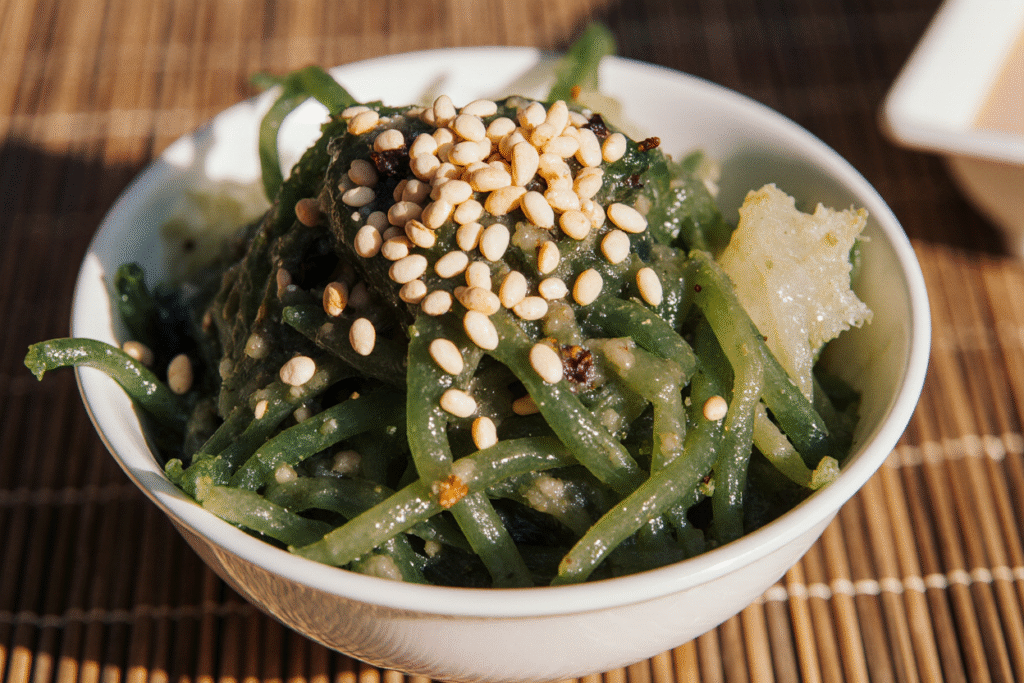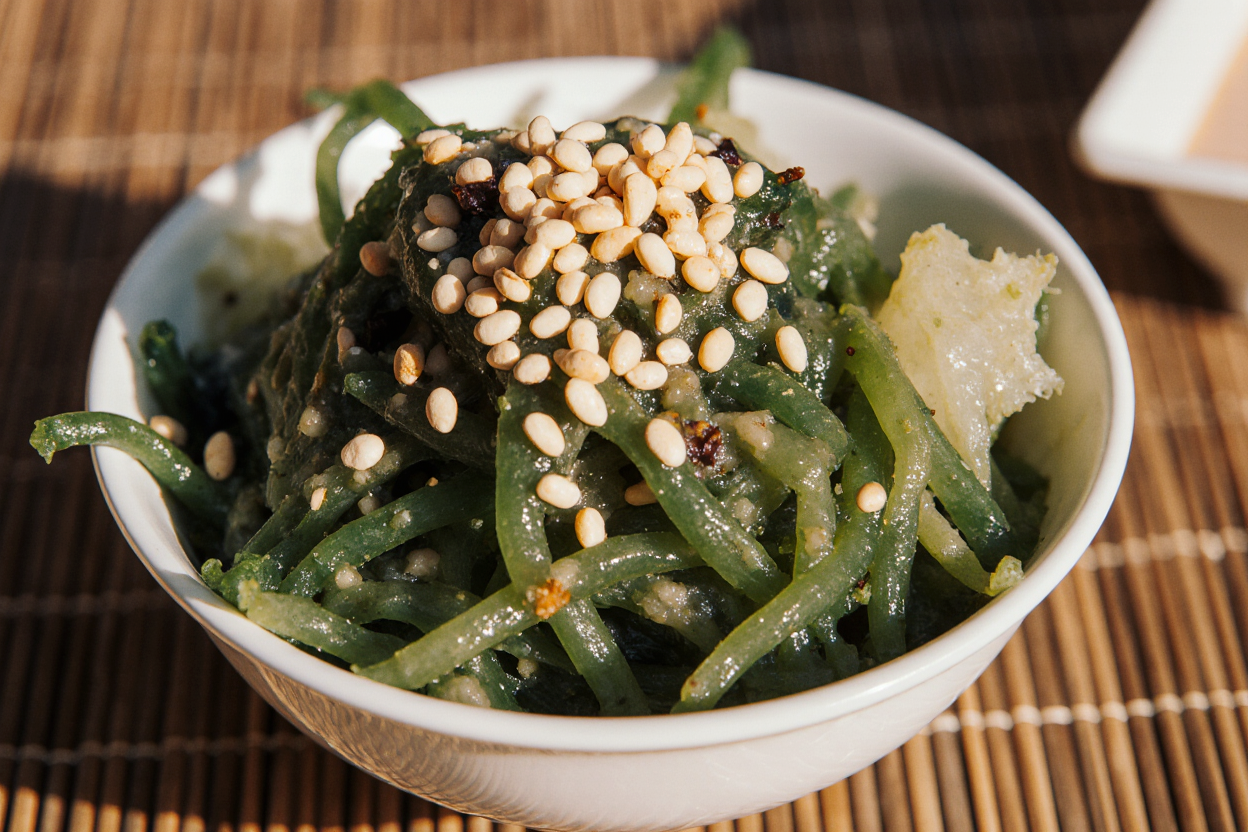
Wakame seaweed is a versatile, nutrient-packed sea vegetable popular in Japanese and Korean cuisine, now gaining traction in American kitchens. Known for its delicate texture and subtle sweetness, wakame adds depth to soups, salads, and stir-fries. Typically sold dried, it’s easy to store and quickly rehydrates with a brief soak in water.
Beyond flavor, wakame is a superfood loaded with iodine, calcium, magnesium, iron, and vitamins A, C, D, E, and K. It supports thyroid health, bone strength, and overall wellness, making it perfect for plant-based and dairy-free diets. In this guide, you’ll learn how to select, store, and cook wakame, along with creative recipe ideas that bring this sea vegetable into everyday meals.
Why You’ll Love This Wakame Seaweed
Wakame is loved for its mild umami flavor, tender texture, and impressive health benefits. It’s easy to prepare—just soak dried wakame for a few minutes—and its subtle taste works in soups, salads, grain bowls, and even fusion recipes.
Low in calories but high in fiber and minerals, wakame supports digestion, thyroid function, and bone health. Its adaptability makes it suitable for vegan, vegetarian, gluten-free, and paleo diets. Whether used in traditional Japanese dishes like miso soup or creative modern recipes, wakame adds a unique, nutrient-rich twist to any meal.
What You’ll Need
Wakame is easy to work with and needs only a few simple ingredients. For a basic salad, you’ll need 1/4 cup dried wakame, 1 small cucumber, 2 tablespoons rice vinegar, 1 tablespoon soy sauce or tamari, 1 teaspoon sesame oil, and 1 teaspoon toasted sesame seeds. Optional extras like grated ginger or sliced green onions add flavor. For soups, add vegetable broth, miso paste, or tofu to make a nutrient-rich, comforting dish. Keeping it simple lets wakame’s natural flavor shine.
How to Make Wakame Seaweed
Rehydrating Wakame:
- Soak 1/4 cup dried wakame in 1 cup cool water for 5–10 minutes.
- Drain and gently squeeze; it expands to about 3/4 cup.
Quick Wakame Salad:
- Rehydrated wakame – 3/4 cup
- Cucumber – 1 small, thinly sliced
- Rice vinegar – 2 tbsp
- Soy sauce/tamari – 1 tbsp
- Sesame oil – 1 tsp
- Toasted sesame seeds – 1 tsp
- Optional: grated ginger – 1/2 tsp, green onions – 1 tbsp
Instructions:
- Toss wakame and cucumber in a bowl.
- Mix rice vinegar, soy sauce, sesame oil, and optional ginger.
- Pour dressing over salad and toss gently.
- Sprinkle with sesame seeds and green onions before serving.

You Must Know
Wakame may look delicate, but there are a few key tips to ensure the best results. Always rehydrate it in cool water, not hot, to preserve its tender texture and subtle flavor. Over-soaking can make it too soft and slimy, so keep it around 5–10 minutes. Also, dried wakame expands significantly—roughly three times its original size—so measure carefully to avoid using too much.
When adding wakame to soups or stir-fries, add it toward the end of cooking. Excess heat can make it overly soft and reduce its vibrant green color. Keep in mind that wakame contains natural sodium, so adjust added salt or soy sauce accordingly. Lastly, choose high-quality, food-grade wakame from trusted brands to ensure it’s clean, safe, and free of grit. These small precautions will make a big difference in flavor, texture, and overall enjoyment.
Perfecting the Cooking Process
Perfect wakame dishes rely on balance and timing. For salads, make sure the wakame is tender but not mushy, paired with crisp vegetables and light dressings to highlight its natural sweetness. In soups, add wakame at the very end, just before serving, so it retains texture and color. For stir-fries, toss briefly over medium heat with a bit of oil and seasoning; prolonged cooking can make it rubbery.
Experimenting with flavor combinations is also key. Wakame pairs beautifully with citrus, sesame, ginger, tofu, mushrooms, and even grains like rice or quinoa. Keep sauces light—avoid overpowering flavors that can mask its delicate taste. By paying attention to soaking times, heat exposure, and complementary ingredients, you can consistently create dishes that showcase wakame’s unique umami, texture, and nutritional benefits.
Add Your Touch Wakame Seaweed
Wakame is wonderfully versatile, allowing you to personalize dishes to your taste. Add a splash of citrus like lemon or yuzu to brighten a salad, or toss it with shredded carrots, bell peppers, or avocado for extra color and crunch. For soups, try blending wakame into miso or vegetable broth for a richer umami flavor, or add cubes of tofu and mushrooms for added protein and texture.
You can also experiment with seasonings—ginger, garlic, chili flakes, or sesame seeds complement wakame beautifully. Even grains like rice, quinoa, or soba noodles benefit from the subtle ocean flavor wakame brings. The key is balance: keep other flavors light and fresh so the wakame remains the star of the dish. A small tweak, like a dash of sesame oil or a sprinkle of fresh herbs, can elevate a simple dish into something extraordinary.
Storing & Reheating
Proper storage keeps wakame fresh and ready to use. Dried wakame should be kept in an airtight container in a cool, dry place, away from sunlight. It can last up to a year if stored properly. Once rehydrated, it should be used within 2–3 days and kept in a sealed container in the refrigerator.
Another fan-favorite you’ll love.
When reheating soups or stir-fries with wakame, avoid high heat. Simply warm gently on the stove or in the microwave until heated through; prolonged cooking can make the seaweed lose its tender texture and vibrant color. For salads, serve immediately after adding dressing to maintain the crispness of accompanying vegetables. By following these storage and reheating tips, you’ll enjoy wakame at its best every time.
Chef’s Helpful Tips for Wakame Seaweed
Professional chefs often emphasize simplicity when working with wakame. Always soak it in cool water to preserve its delicate texture and flavor, and drain thoroughly before use. Pair wakame with light, fresh ingredients like cucumbers, radishes, or citrus to highlight its natural sweetness. Toasted sesame seeds or a dash of sesame oil can add depth without overpowering the seaweed.
Perfect for weeknight dinners.
Timing is also critical—add wakame at the end of cooking for soups or stir-fries to maintain its vibrant color and tender bite. Taste frequently and adjust seasoning, keeping in mind that wakame naturally contains sodium. Lastly, don’t be afraid to experiment: wakame works beautifully in salads, grain bowls, soups, and even creative fusion dishes. A little practice and attention to detail will ensure consistently flavorful results.
FAQ for Wakame SeaweedWakame Seaweed
Q: Is wakame healthy?
A: Yes! Wakame is low in calories but packed with iodine, calcium, magnesium, and vitamins, making it excellent for thyroid and bone health.
Pair it with this easy favorite.
Q: How long does dried wakame last?
A: Stored in a cool, dry place in an airtight container, dried wakame can last up to a year.
Q: Can I eat wakame raw?
A: Yes. Once rehydrated, it’s safe to eat raw in salads or as a garnish.
Q: How do I prevent wakame from getting slimy?
A: Soak in cool water for 5–10 minutes and avoid overcooking. Add it to hot dishes at the end to maintain texture.
Q: Can I use wakame in non-Asian recipes?
A: Absolutely. It pairs well with grains, vegetables, citrus, and light dressings, making it versatile for fusion dishes.
Conclusion
Wakame seaweed is a simple yet powerful ingredient that brings flavor, texture, and nutrition to your kitchen. Its mild umami taste, tender texture, and health benefits make it a versatile addition to salads, soups, stir-fries, and grain bowls. With proper soaking, careful cooking, and thoughtful pairing with fresh ingredients, wakame can transform everyday dishes into something extraordinary.
Whether you’re new to sea vegetables or a seasoned cook, wakame’s ease of use and adaptability make it a pantry staple worth keeping on hand. By following the tips and techniques outlined in this guide, you’ll confidently incorporate wakame into your meals, enjoying its vibrant color, subtle sweetness, and nutritional boost. Experiment, have fun, and let this ocean-fresh superfood elevate your cooking.

Everything You Need to Know About Wakame Seaweed: Guide & Recipes
Description
A refreshing and nutrient-packed wakame salad, perfect as a light appetizer or a healthy side dish. Quick to prepare and bursting with umami flavor.
Ingredients
Instructions
Soak dried wakame in 1 cup cool water for 5–10 minutes. Drain and gently squeeze out excess water.
In a bowl, combine wakame and cucumber slices.
Whisk together rice vinegar, soy sauce, sesame oil, and optional ginger.
Pour dressing over salad and toss gently.
Sprinkle with sesame seeds and green onions before serving.
Notes
- Add wakame at the end for soups or stir-fries to maintain texture and color.
Store rehydrated wakame in the refrigerator for up to 2–3 days.
Experiment with toppings like avocado, shredded carrots, or citrus for extra flavor.

